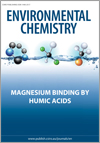Environmental context. The behaviour of magnesium, which is an essential element for all living organisms, in terrestrial environments is influenced by natural organic matter. This study shows that magnesium binding by terrestrial humic acids exhibits a pronounced ionic strength-dependence indicating a strong preference for electrostatic binding to humic acids. This interaction is expected to influence the mobility of humic substances and their associated trace elements.

Environmental Chemistry
Volume 15 Number 6 2018
EN18087Glyphosate removal from water by functional three-dimensional graphene aerogels

Environmental context. Glyphosate is a non-selective and widely used herbicide commonly found as a contaminant in water. This work reports the use of functional graphene aerogels prepared with carboxymethyl chitosan and graphene oxide for the efficient adsorption and removal of glyphosate present in water samples. The procedure has potential to successfully treat water bodies contaminated with glyphosate.
Environmental context. Polyacrylamide and its derivatives may enter the natural environment as a consequence of their wide use in various industrial applications. This study demonstrates the application of a quartz crystal microbalance and atomic force microscopy to study the molecular interactions between polyacrylamides and humic acids under various solution chemistries. The knowledge obtained can be used to understand and predict the environmental behaviour of polyacrylamides.
Environmental context. Polycyclic aromatic hydrocarbons are widespread carcinogenic compounds resulting from incomplete combustion of fossil fuels. We report a robust analytical method suitable for detecting these compounds at trace levels in various types of environmental waters. The method allows for accurate monitoring of the levels and behaviour of these priority environmental pollutants.
EN18030Environmental chiral analysis of β-blockers: evaluation of different n-alkyl-modified SBA-15 mesoporous silicas as sorbents in solid-phase extraction
Environmental context. β-Blockers are important chiral pharmaceuticals found as micropollutants in environmental waters as a result of incomplete removal during wastewater treatment. Because they display enantioselective toxicity, it is necessary to include chiral information in an environmental risk assessment. We have developed an analytical method using mesoporous silica for extracting β-blockers in water samples before their specific chiral analysis.
Environmental context Urea is an important component of dissolved organic nitrogen in rainfall and aerosols, but the sources and the mechanisms of its production are not well understood. This computational study explores the effects of urea and water on the hydrolysis of NO2 and urea nitrate production. The results will aid our interpretation of the role of urea in the formation of atmospheric secondary nitrogen contaminants and aerosols.



